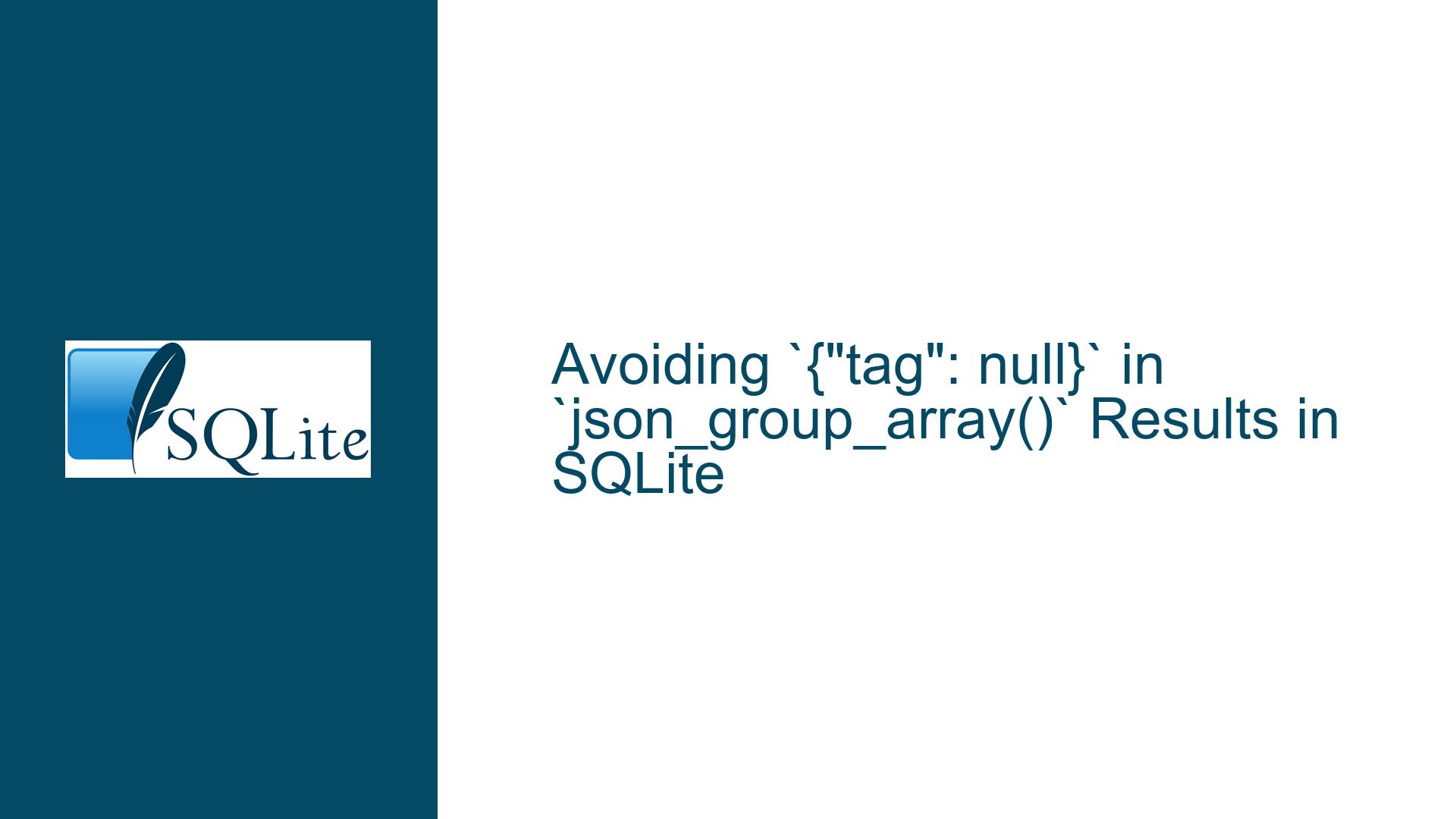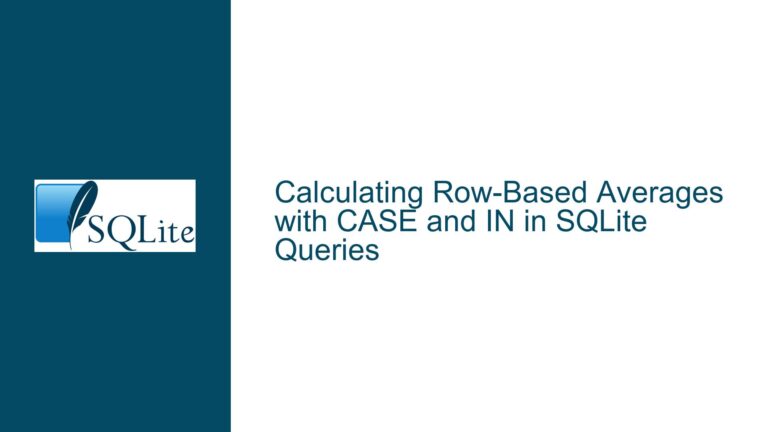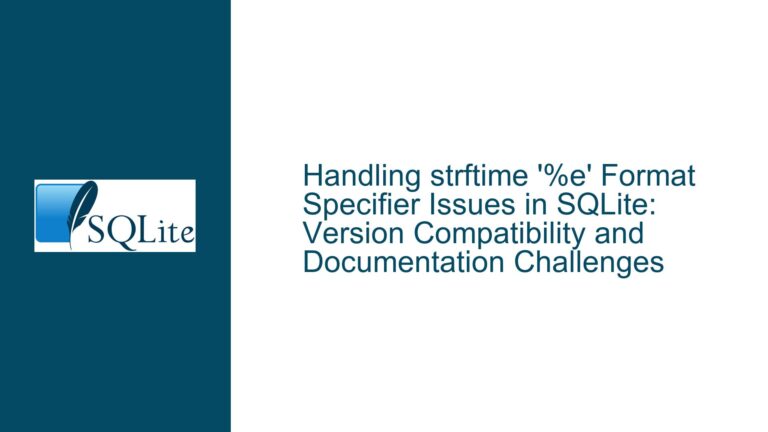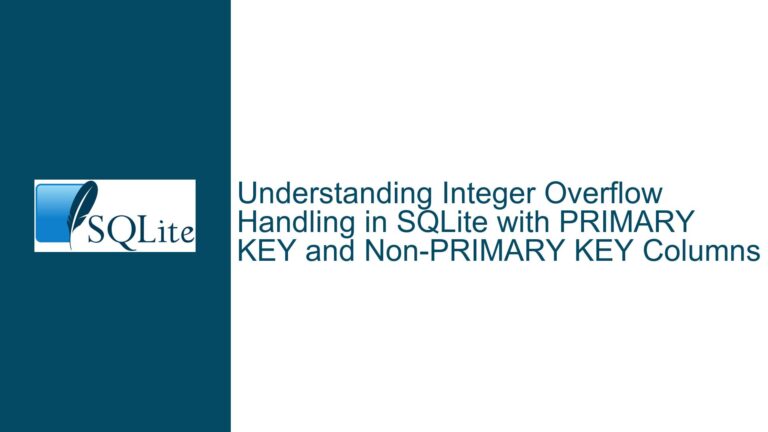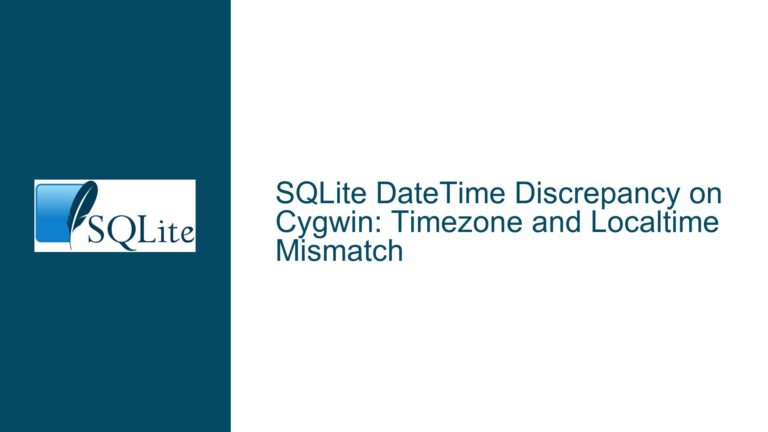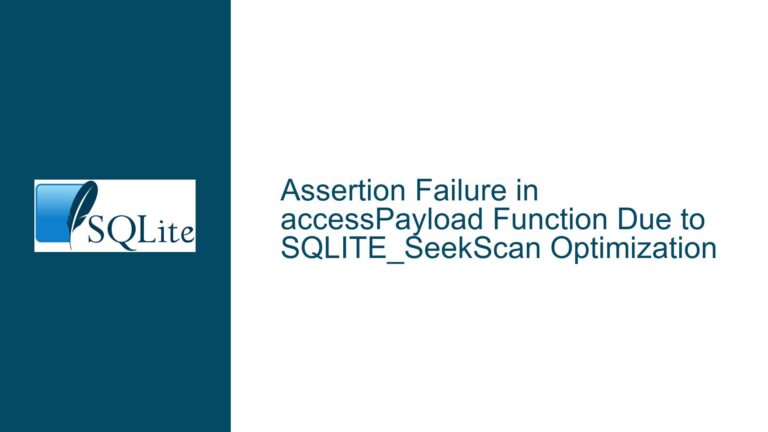Avoiding `{“tag”: null}` in `json_group_array()` Results in SQLite
Issue Overview: Handling Null Values in JSON Aggregation
When working with SQLite, particularly in scenarios involving JSON aggregation functions like json_group_array(), a common issue arises when dealing with null values. In the context of the provided query, the goal is to aggregate tags associated with blog entries into a JSON array. However, when a blog entry has no associated tags, the query returns [{"tag": null}] instead of the desired empty array []. This behavior occurs because the LEFT JOIN operation includes rows where no matching tags exist, resulting in null values for the blog_tag.tag column.
The core issue lies in how SQLite handles null values within JSON aggregation functions. By default, json_group_array() includes all rows, even those with null values, which leads to the inclusion of {"tag": null} in the resulting JSON array. This can be problematic for applications that expect a clean, empty array when no data is present, as it introduces unnecessary noise and complicates data processing on the client side.
Possible Causes: Why {"tag": null} Appears in Results
The appearance of {"tag": null} in the JSON array is a direct consequence of the LEFT JOIN operation combined with the behavior of json_group_array(). Let’s break down the causes:
Left Join Behavior: The
LEFT JOINoperation ensures that all rows from theblog_entrytable are included in the result set, even if there are no matching rows in theblog_entry_tagsorblog_tagtables. When no matching tags exist, theblog_tag.tagcolumn is populated with null values.JSON Aggregation with Null Values: The
json_group_array()function aggregates all rows, including those with null values. When constructing the JSON object usingjson_object('tag', blog_tag.tag), the null value forblog_tag.tagresults in{"tag": null}being added to the array.Grouping and Aggregation: The
GROUP BYclause groups the results byblog_entry.id, and the aggregation function processes all rows within each group. Since null values are included in the aggregation, they appear in the final JSON array.Lack of Filtering: The initial query does not include any mechanism to filter out rows where
blog_tag.tagis null. As a result, these rows are included in the aggregation, leading to the undesired{"tag": null}entries.
Troubleshooting Steps, Solutions & Fixes: Eliminating {"tag": null} from JSON Arrays
To address the issue of {"tag": null} appearing in the JSON array, several approaches can be taken. Each solution has its own merits and trade-offs, and the choice of method depends on the specific requirements of the application and the complexity of the query.
1. Using the FILTER Clause with json_group_array()
One of the most elegant solutions is to use the FILTER clause in conjunction with json_group_array(). This approach allows you to exclude rows where blog_tag.tag is null from the aggregation process. Here’s how the modified query looks:
SELECT
blog_entry.id,
blog_entry.title,
json_group_array(
json_object('tag', blog_tag.tag)
) FILTER (
WHERE blog_tag.tag IS NOT NULL
) AS tags
FROM
blog_entry
LEFT JOIN blog_entry_tags ON blog_entry.id = blog_entry_tags.entry_id
LEFT JOIN blog_tag ON blog_tag.id = blog_entry_tags.tag_id
GROUP BY
blog_entry.id
ORDER BY
blog_entry.id;
Explanation:
- The
FILTERclause is applied to thejson_group_array()function, specifying that only rows whereblog_tag.tagis not null should be included in the aggregation. - This effectively excludes rows with null values, resulting in an empty array
[]for blog entries with no tags.
Advantages:
- The solution is concise and leverages SQLite’s built-in functionality.
- It maintains the readability of the query and avoids the need for additional string manipulation.
Considerations:
- The
FILTERclause is a relatively recent addition to SQLite (introduced in version 3.30.0). Ensure that your SQLite version supports this feature before using it.
2. Using a Subquery to Filter Null Values
Another approach is to use a subquery to filter out rows with null values before performing the aggregation. This method can be useful if you need to support older versions of SQLite that do not support the FILTER clause. Here’s how the query can be structured:
SELECT
blog_entry.id,
blog_entry.title,
(
SELECT json_group_array(json_object('tag', blog_tag.tag))
FROM blog_entry_tags
LEFT JOIN blog_tag ON blog_tag.id = blog_entry_tags.tag_id
WHERE blog_entry_tags.entry_id = blog_entry.id
AND blog_tag.tag IS NOT NULL
) AS tags
FROM
blog_entry
ORDER BY
blog_entry.id;
Explanation:
- The subquery is used to aggregate tags for each blog entry, filtering out rows where
blog_tag.tagis null. - The main query selects the blog entry details and includes the result of the subquery as the
tagscolumn.
Advantages:
- This approach is compatible with older versions of SQLite.
- It provides a clear separation of concerns, with the subquery handling the aggregation and filtering.
Considerations:
- The use of a subquery can increase the complexity of the query, especially if additional joins or conditions are involved.
- Performance may be impacted if the subquery is executed for each row in the result set.
3. Using COALESCE to Handle Null Values
The COALESCE function can be used to replace null values with a default value before performing the aggregation. While this approach does not directly solve the problem of excluding null values, it can be used to ensure that the JSON array contains meaningful data. Here’s an example:
SELECT
blog_entry.id,
blog_entry.title,
json_group_array(
json_object('tag', COALESCE(blog_tag.tag, ''))
) AS tags
FROM
blog_entry
LEFT JOIN blog_entry_tags ON blog_entry.id = blog_entry_tags.entry_id
LEFT JOIN blog_tag ON blog_tag.id = blog_entry_tags.tag_id
GROUP BY
blog_entry.id
ORDER BY
blog_entry.id;
Explanation:
- The
COALESCEfunction is used to replace null values in theblog_tag.tagcolumn with an empty string''. - This ensures that the JSON array does not contain
{"tag": null}, but instead contains{"tag": ""}.
Advantages:
- This approach is simple and does not require advanced SQL features.
- It ensures that the JSON array always contains valid JSON objects, even if the tag value is empty.
Considerations:
- The use of
COALESCEdoes not eliminate null values from the aggregation; it merely replaces them with a default value. - This approach may not be suitable if the goal is to exclude null values entirely.
4. Using CASE Statements to Conditionally Include Rows
The CASE statement can be used to conditionally include or exclude rows based on the value of blog_tag.tag. This approach provides fine-grained control over which rows are included in the aggregation. Here’s how the query can be structured:
SELECT
blog_entry.id,
blog_entry.title,
json_group_array(
CASE
WHEN blog_tag.tag IS NOT NULL THEN json_object('tag', blog_tag.tag)
ELSE NULL
END
) AS tags
FROM
blog_entry
LEFT JOIN blog_entry_tags ON blog_entry.id = blog_entry_tags.entry_id
LEFT JOIN blog_tag ON blog_tag.id = blog_entry_tags.tag_id
GROUP BY
blog_entry.id
ORDER BY
blog_entry.id;
Explanation:
- The
CASEstatement is used to conditionally include a JSON object in the aggregation only ifblog_tag.tagis not null. - If
blog_tag.tagis null, theCASEstatement returnsNULL, which is excluded from the aggregation.
Advantages:
- This approach provides flexibility in handling different conditions for including or excluding rows.
- It can be adapted to more complex scenarios where multiple conditions need to be evaluated.
Considerations:
- The use of
CASEstatements can increase the complexity of the query. - This approach may not be as efficient as using the
FILTERclause, especially for large datasets.
5. Using IFNULL to Replace Null Values
The IFNULL function can be used to replace null values with a default value, similar to the COALESCE function. This approach is useful if you want to ensure that the JSON array does not contain null values. Here’s an example:
SELECT
blog_entry.id,
blog_entry.title,
json_group_array(
json_object('tag', IFNULL(blog_tag.tag, ''))
) AS tags
FROM
blog_entry
LEFT JOIN blog_entry_tags ON blog_entry.id = blog_entry_tags.entry_id
LEFT JOIN blog_tag ON blog_tag.id = blog_entry_tags.tag_id
GROUP BY
blog_entry.id
ORDER BY
blog_entry.id;
Explanation:
- The
IFNULLfunction is used to replace null values in theblog_tag.tagcolumn with an empty string''. - This ensures that the JSON array does not contain
{"tag": null}, but instead contains{"tag": ""}.
Advantages:
- This approach is simple and does not require advanced SQL features.
- It ensures that the JSON array always contains valid JSON objects, even if the tag value is empty.
Considerations:
- The use of
IFNULLdoes not eliminate null values from the aggregation; it merely replaces them with a default value. - This approach may not be suitable if the goal is to exclude null values entirely.
6. Using GROUP_CONCAT and String Manipulation
In some cases, it may be necessary to use string manipulation functions to achieve the desired result. This approach involves using GROUP_CONCAT to concatenate tag values and then converting the result into a JSON array. Here’s how the query can be structured:
SELECT
blog_entry.id,
blog_entry.title,
CASE
WHEN GROUP_CONCAT(blog_tag.tag) IS NULL THEN '[]'
ELSE '[' || GROUP_CONCAT(json_object('tag', blog_tag.tag)) || ']'
END AS tags
FROM
blog_entry
LEFT JOIN blog_entry_tags ON blog_entry.id = blog_entry_tags.entry_id
LEFT JOIN blog_tag ON blog_tag.id = blog_entry_tags.tag_id
GROUP BY
blog_entry.id
ORDER BY
blog_entry.id;
Explanation:
- The
GROUP_CONCATfunction is used to concatenate tag values into a comma-separated string. - The
CASEstatement is used to handle cases where no tags are present, returning an empty array[]. - If tags are present, the concatenated string is converted into a JSON array by enclosing it in square brackets
[].
Advantages:
- This approach provides a workaround for cases where
json_group_array()is not available or does not meet the requirements. - It allows for fine-grained control over the format of the JSON array.
Considerations:
- The use of string manipulation can increase the complexity of the query and make it harder to maintain.
- This approach may not be as efficient as using built-in JSON functions, especially for large datasets.
7. Using a Common Table Expression (CTE) to Pre-Filter Data
A Common Table Expression (CTE) can be used to pre-filter the data before performing the aggregation. This approach is useful for complex queries where multiple filtering conditions need to be applied. Here’s how the query can be structured:
WITH filtered_tags AS (
SELECT
blog_entry.id AS entry_id,
blog_tag.tag
FROM
blog_entry
LEFT JOIN blog_entry_tags ON blog_entry.id = blog_entry_tags.entry_id
LEFT JOIN blog_tag ON blog_tag.id = blog_entry_tags.tag_id
WHERE
blog_tag.tag IS NOT NULL
)
SELECT
blog_entry.id,
blog_entry.title,
json_group_array(json_object('tag', filtered_tags.tag)) AS tags
FROM
blog_entry
LEFT JOIN filtered_tags ON blog_entry.id = filtered_tags.entry_id
GROUP BY
blog_entry.id
ORDER BY
blog_entry.id;
Explanation:
- The CTE
filtered_tagsis used to pre-filter the data, excluding rows whereblog_tag.tagis null. - The main query performs the aggregation using the filtered data, ensuring that only non-null tag values are included in the JSON array.
Advantages:
- This approach provides a clear separation of concerns, with the CTE handling the filtering and the main query handling the aggregation.
- It can be adapted to more complex scenarios where multiple filtering conditions need to be applied.
Considerations:
- The use of a CTE can increase the complexity of the query, especially if multiple CTEs are involved.
- Performance may be impacted if the CTE processes a large amount of data.
8. Using json_remove() to Remove Null Entries
If the JSON array already contains {"tag": null} entries, the json_remove() function can be used to remove these entries from the array. This approach is useful if the initial query cannot be modified or if the data is being processed after retrieval. Here’s how the query can be structured:
SELECT
blog_entry.id,
blog_entry.title,
json_remove(
json_group_array(json_object('tag', blog_tag.tag)),
'$[0]'
) AS tags
FROM
blog_entry
LEFT JOIN blog_entry_tags ON blog_entry.id = blog_entry_tags.entry_id
LEFT JOIN blog_tag ON blog_tag.id = blog_entry_tags.tag_id
GROUP BY
blog_entry.id
ORDER BY
blog_entry.id;
Explanation:
- The
json_remove()function is used to remove the first element of the JSON array, which is assumed to be{"tag": null}. - This approach is a workaround and may not be suitable for all scenarios, especially if the array contains multiple elements.
Advantages:
- This approach provides a quick fix for removing null entries from the JSON array.
- It can be used in scenarios where modifying the initial query is not feasible.
Considerations:
- The use of
json_remove()is a workaround and may not be as efficient or reliable as other solutions. - This approach assumes that the first element of the array is always
{"tag": null}, which may not be the case in all scenarios.
9. Using json_each() to Iterate Over JSON Arrays
The json_each() function can be used to iterate over the elements of a JSON array and filter out null values. This approach is useful if the JSON array is already constructed and needs to be processed. Here’s how the query can be structured:
SELECT
blog_entry.id,
blog_entry.title,
json_group_array(
json_object('tag', json_each.value)
) AS tags
FROM
blog_entry
LEFT JOIN blog_entry_tags ON blog_entry.id = blog_entry_tags.entry_id
LEFT JOIN blog_tag ON blog_tag.id = blog_entry_tags.tag_id
LEFT JOIN json_each(json_group_array(json_object('tag', blog_tag.tag))) AS json_each
WHERE
json_each.value IS NOT NULL
GROUP BY
blog_entry.id
ORDER BY
blog_entry.id;
Explanation:
- The
json_each()function is used to iterate over the elements of the JSON array generated byjson_group_array(). - The
WHEREclause filters out elements where the value is null, ensuring that only non-null values are included in the final JSON array.
Advantages:
- This approach provides a flexible way to process JSON arrays and filter out unwanted elements.
- It can be adapted to more complex scenarios where multiple conditions need to be evaluated.
Considerations:
- The use of
json_each()can increase the complexity of the query and make it harder to maintain. - Performance may be impacted if the JSON array contains a large number of elements.
10. Using json_patch() to Modify JSON Arrays
The json_patch() function can be used to modify JSON arrays by applying a patch that removes null entries. This approach is useful if the JSON array is already constructed and needs to be modified. Here’s how the query can be structured:
SELECT
blog_entry.id,
blog_entry.title,
json_patch(
json_group_array(json_object('tag', blog_tag.tag)),
'{"$remove": ["$[0]"]}'
) AS tags
FROM
blog_entry
LEFT JOIN blog_entry_tags ON blog_entry.id = blog_entry_tags.entry_id
LEFT JOIN blog_tag ON blog_tag.id = blog_entry_tags.tag_id
GROUP BY
blog_entry.id
ORDER BY
blog_entry.id;
Explanation:
- The
json_patch()function is used to apply a patch that removes the first element of the JSON array, which is assumed to be{"tag": null}. - This approach is a workaround and may not be suitable for all scenarios, especially if the array contains multiple elements.
Advantages:
- This approach provides a quick fix for removing null entries from the JSON array.
- It can be used in scenarios where modifying the initial query is not feasible.
Considerations:
- The use of
json_patch()is a workaround and may not be as efficient or reliable as other solutions. - This approach assumes that the first element of the array is always
{"tag": null}, which may not be the case in all scenarios.
Conclusion
Handling null values in JSON aggregation functions like json_group_array() in SQLite can be challenging, but there are several approaches to address the issue. The most elegant solution is to use the FILTER clause with json_group_array(), which allows you to exclude rows with null values from the aggregation. This approach is concise, readable, and leverages SQLite’s built-in functionality.
For scenarios where the FILTER clause is not available, alternative approaches such as using subqueries, COALESCE, CASE statements, or IFNULL can be employed. Each method has its own advantages and trade-offs, and the choice of solution depends on the specific requirements of the application and the complexity of the query.
By understanding the underlying causes of the issue and exploring the various solutions, you can ensure that your SQLite queries return clean, accurate JSON arrays
